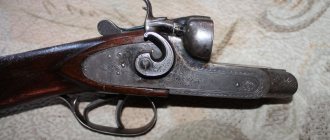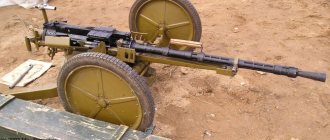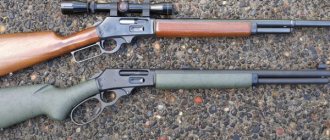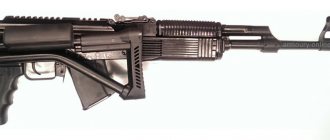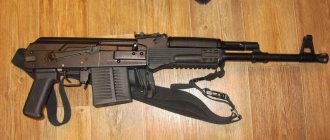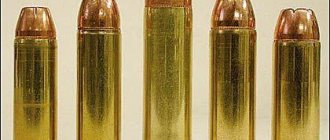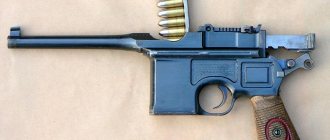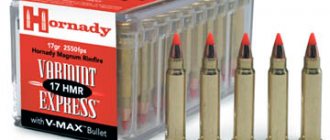MAKSIMOV.SU
Leonid Ilyich Brezhnev loved hunting and, being an expert, valued high-quality weapons.
And it was on his initiative that in the USSR, in the 1970s, the development of high-quality hunting rifles began.
Initially
these were two self-loading models MTs 125, MTs 126 and one carbine with manual reloading - MTs 19-07, which is one of two representatives of the MTs 19 family.
The MTs 19-07 is produced under the 7.62x51 cartridge, while the “nine” uses a powerful 9.3x64 cartridge, which covers all conceivable tasks when hunting the “Russian troika”, but is most suitable for hunting the largest animals in Russia - the giant elk and Far Eastern bear.
When I first picked up this weapon, at first it didn’t make much of an impression on me: it was somehow “sleek,” outwardly similar to the “trade” MTs 20-01 made in Tula. But what caught my attention was the solidity of the design, as well as the excellent processing of the metal, its excellent bluing and the precisely adjusted joint between the barrel breech and the receiver. That's all. Everything seemed too simple then – steel and walnut. And - no external shine and gloss characteristic of modern imported hunting weapons.
Several years passed, during which I developed a practical interest in TsKIB weapons in general and in classic large-caliber weapons in particular. Much was realized anew, something was rethought. And most importantly, it was a good opportunity to carefully study and try out that same carbine in practice.
There is only one way to obtain the most complete and reliable information - turning to the original source. In this case, I turned for help to the designer of the SOO TsKIB Arkady Konstantinovich Zakharyan, who was at the origins of the appearance of MTs 19.
A.K. Zakharyan was born in 1950 in Baku. In 1967, his family moved to Tula. In the same year, Arkady entered TsKIB SOO as a draftsman-designer, then the army, institute and again TsKIB SOO. Currently, Arkady Konstantinovich works as deputy head of the department for the development of sporting and hunting weapons. Developed carbines MTs 19-07, MTs 19-09, MTs 20-07. In recent years, he has been developing new models MTs-555 and MTs-557.
Design features of MC 19
It is often claimed that the MC 19 rifles are copied from the Mannlicher system. At first glance, it is so – the same smooth lines of the bolt group, the same rotary magazine and the pronounced “classic” weapon. And only upon closer examination and comparison does it become clear that there is good reason to talk about the originality of any weapon model of the MC brand. And it doesn’t matter that the external design of the MTs 19 is somewhat reminiscent of an Austrian rifle. And let the rotary magazine have been the calling card of the same Mannlicher for more than 100 years.
The time has come to understand that any modern small arms system is a more or less successful compilation of long-known and proven technical solutions, combined by the designer to most effectively complete the task. In any case, there will be original developments here, which allows us to talk about truly new designs.
In the case of the MTs 19, as with any TsKIB weapon, the developers pursued the goal of obtaining a reliable, accurate and beautiful high-class weapon. This is what was implemented in practice.
Let's start by trying to determine what it is - a high-class weapon. According to A. Zakharyan, such a weapon should have all the signs of “thoroughbred” and be impeccable, like a beautiful woman, when looking at whom you don’t want to take away or add anything.
Style defines the silhouette. And it’s hard to disagree with this. And the creators of high-quality weapons in any country in the world strive for these ideals.
Reliability
A high-quality hunting weapon, in the opinion of TsKIB designers, should not be inferior in reliability to domestic army models. Let's not forget that the Central Design Research Bureau is part of the elite defense unit, and its main activity is work in the field of army weapons. Hence the requirements and test conditions: MC brand hunting carbines are tested according to the same scheme as military developments. This determines their high reliability.
As a clear example: the MTs 19 bolt (which traces its history back to the MTs 20-01 gun bolt and is a completely original TsKIB design) can be completely disassembled by hand for its maintenance. For field conditions this is a very important point. Anything can happen on a hunt. And a dusty or over-lubricated bolt can cause misfires or delays when firing.
Plus, the design of the bolt group itself is quite simple. All gunsmiths know that the most difficult thing is to create a simple, but most efficient design. European manufacturers do not always adhere to the axiom that says: the more intermediaries, the greater the likelihood of refusal. TsKIB honors old traditions.
Accuracy
Of course, a high-quality weapon must be accurate and have appropriate combat accuracy. MC carabiners also meet these parameters. Here I would like to cite one fact: when testing the first copy of the MTs 19, carried out in 1978, all five shooters received an accuracy of fire from 18 to 26 mm, firing a series of five shots.
Agree – even by today’s standards, this is a very good result. All TsKIB weapon barrels are made from very well-proven special steel (30HN2MFA GOST V 5160-89). The rifling in rifle barrels is produced by electrochemistry, which, together with a correctly calculated barrel contour, ensures the absence of stress in the metal and good thermal stability. The barrel length of the MC 19-09 is 650 mm, with a total length of the weapon of 1160 mm.
The combination of unconditional design “thoroughbredness”, originality of design, high reliability and excellent accuracy are the very criteria that determine the high class of hunting weapons. Let's add a limited edition here and pay attention to the characteristics of the materials used.
It is precisely here that it should be noted that now many well-known manufacturers of hunting weapons are guilty of striving to reduce the cost of products by using plastic and light alloys. The capabilities of modern CNC machines make it possible to assemble weapons without the use of a file, in other words, with a minimal investment of expensive manual labor of highly qualified specialists.
As a result, the conveyor produces a huge number of absolutely identical machine-made weapons, which, together with the content of a large amount of composite materials and duralumin in the design, classifies it as a serial hunting weapon, nothing more.
Of course, the use of compromise materials and technologies makes it possible to obtain lighter and cheaper weapons. But TsKIB deliberately uses expensive and labor-intensive technologies, according to a long-established tradition. And, you see, 3.6 kg is not that much weight for a carbine made of steel and walnut, using a 9.3x64 mm cartridge.
Shop
Another example: let’s take the same modern Mannlicher, which, with its excellent action (barrels for these rifles were made in Izhevsk not so long ago) and the beauty of its design, has a plastic magazine and a safety lever. But in the MC 19 there is no plastic and cannot be in principle, and the magazine is made by milling from aluminum alloy B95, which in its characteristics is very close to steel and is widely used in the manufacture of highly loaded parts.
One interesting point is that both magazines that come with each MC magazine are individually adjusted to the weapon in such a way that when feeding, contact between the cartridge and the receiver is completely eliminated. This is one of the factors that has a positive effect on the stability of the battle. The MTs 19 magazine has a double-sided latch and reliable fixation, is convenient in equipment and compact in itself.
The choice of this particular rare design of the carbine was determined by the desire to obtain a gain in the height of the middle part of the carbine, with a magazine capacity of five rounds, which is above average. At the same time, the weapon, in the area of the fore-end, became more “graspy” and acquired pronounced recognition.
Open sights are represented by a classic open front sight and a rear sight with two lifting flaps, allowing shooting at 100 and 300 m.
Bracket
for an optical sight
All brackets for MC brand weapons are distinguished by ease of use, reliability and original design, ensuring the precision installation of the sight necessary for weapons with high accuracy of combat.
An optical sight on an MC weapon is usually installed domestically, but the installation of any optics is possible, as well as the design of any bracket that meets customer requirements.
Trigger mechanism
The MTs 19 trigger mechanism has a trigger that is automatically turned off when the bolt approaches the rearmost position and when the carbine is put on safety. The trigger characteristics are excellent and are equally good for both offhand shooting with open sights and precision shooting with optics.
Cartridge 9.3x64
Little-known pages of the history of colonial Germany are associated with this cartridge. After WWI, the Germans lost almost all their colonies. But, which is understandable, even in the devastated country there were people who had the desire and opportunity to hunt outside Germany, incl. – on large and dangerous animals.
Demand creates supply. And the German hunters received “their” cartridge, loudly called in the Brenneke catalogs the cartridge “for any animal on Earth.” This is how the difficult and not very well-known history of the German “African Nine” began, initially intended to become a competitor to one of the best cartridges in this class, the 375 H&H, and the popular 9.3x62.
The Germans had a long tradition of developing large bore cartridges, but these were primarily chambered and had a case flange. To use the Mauser rifle mod. 1898, a wafer chuck was needed. And in 1905, the 9.3x62 cartridge became such, with a case diameter equal to that of the 8x57 army rifle cartridge. But its power was not always sufficient. It's time for 9.3x64.
The goal of this development was to obtain the maximum power cartridge that could be used in the standard M98, without significant modification. Indeed, the 9.3x64 only required a re-barrel and minor processing of the bolt cup and magazine window, but was at the same time 15% more powerful than the 9.3x62. The author of the new cartridge was Wilhelm Brenneke.
in the photo below, the domestically produced 9.3x64 cartridge is located second from the left
Usually the creation of this cartridge dates back to 1927. But there is mention that 9.3x64 was developed back in 1910. Considering the fact that Germany lost colonies after WWII and the terrible devastation after Versailles, this version has a right to exist.
If we take the development date of 9.3x64 in 1927 as the main version, then it is worth considering that the scope of application of this cartridge sharply narrowed after the war. However, small quantities of the cartridge and weapon appeared commercially. They gained some popularity and are still produced in Germany: these are RWS cartridges, with a 19-gram UNI bullet (formerly called TUG) and a 14.6-gram DK high-speed bullet. Recently, “original Brennekes” have appeared with the same 19-gram TUG bullet.
In the USA, this cartridge is produced by A-Square, with “triad” bullets - monolithic bronze, semi-expansive and expansive. In those African countries where 9.3 caliber is permitted, these cartridges are successfully used to shoot the largest animals, up to and including elephants.
In Russia, the patron found a “second homeland”.
Perhaps the main factor was that it was accepted by the Russian military. Modern armies are strengthening the armor protection of the ordinary soldier, and our army cartridges - rifle-machine gun 7.62x54R and machine gun 5.45x39 are becoming ineffective. For example, the ceramic panels of modern US body armor “hold” the SVD armor-piercing bullet, and our soldiers find themselves almost unarmed against Western-style heavy infantry. The 9.3x64 cartridge, with its energy, is dangerous for the enemy even at long distances, and weapons for it can be obtained by altering existing samples.
According to Western data, the Russian army is armed with SVDK rifles and 9SN (?) cartridges with bullets weighing 16.6 g and a steel core, which can destroy body armor at distances of up to 600 meters.
Civilian versions of the cartridge - half-shell and shell - are produced in Novosibirsk and Barnaul. They have similar passport data (bullet weight 17.4 g), but differ slightly in ballistics and require separate shooting. TsKIB weapons are zeroed with a Novosibirsk half-shell.
The first 9x64 with a half-flange based on 8.2x66 was made by M.N. Blum in 1956, and 9x64 of the Brenneke type was made by M.M. Blum in 1970, who was involved in adapting 9.3x64 for domestic production.
Conclusion
MTs 19-09 is that very prestigious “classic” that is now talked about so much in the world weapons periodicals. This is a beautiful, reliable and well-made weapon, into which a large amount of manual labor has been invested by our craftsmen. By purchasing a carbine or gun under the MC brand, no matter whether it is Soviet or modern, a hunter becomes the owner of a truly unique weapon, which by all criteria is a high-class weapon.
People famous in the fields of politics and art hunt with MTs 19-09 carbines. This article illustrates the carbine of Andrei Parshev, a connoisseur of TsKIB weapons, an expert in the field of small arms and the author of the acclaimed book “Why Russia is not America.”
And now, interesting facts, usually inaccessible and therefore of concern to all owners of MC weapons: the production of MTs 19-09 was 105 units, and MTs 19-07 – 280 units. As you can see, these are more than modest numbers, but they determine the rarity of the “nineteenth” MC model.
The price for carbines in 2008 was determined: MTs 19-07 - 83,000 rubles, MTs 19-09 - 92,000 rubles. The price range, as usual, is determined by the market. Pay attention to the design of the quick-release swivels. If the swivel is removed, the place where it is attached becomes almost invisible, and the look of the weapon becomes more noble
The MTs-19-09 carbine is equipped with a traveling kit for weapon care, where you can also place a spare magazine and ammunitionPS: in the next article about weapons produced by TsKIB, we will talk about a very interesting model - MTs-105 and its modifications, learn about the prospects of TsKIB and its latest serial developments.
The article was published in the magazine “Master Gun”, in the July 2012 issue
Hunting carbine MTs-19
HUNTING CARBINE MC-19
The MTs 19 hunting carbine is produced at the famous Tula Arms Factory (TOZ), and is a continuation of the MTs brand weapon line. Among hunting firearms, smooth-bore, rifled, and combined, a special place is occupied by carbines, which allow the hunter, depending on the caliber and cartridge, to shoot various game - from wood grouse or fox to elk and wild boar. Hunting carbines must meet stringent requirements: they are designed for accurate shooting up to 500 m, sometimes more, for example in the mountains, and must provide the greatest accuracy of combat and sufficient lethality at these ranges. Various hunts, the size and survivability of the prey being shot, the range of possible shooting at an animal, and the terrain impose additional requirements on the accuracy of combat and the rate of fire of modern carbines. Thus, the position of the carbine in the hunting weapon system is complex and ambiguous. When choosing carbines, it is necessary to take into account the whole range of their qualities in combination with the tastes of hunters: the design and artistic design of the sample, the cartridge used, weight and dimensions, cost. All this determines the many views of specialists on a hunting carbine as a weapon, and the variety of requirements placed on it. A hunting carbine is usually single-barreled, single-shot or repeating, or self-loading, with a heavy and often elongated barrel. The length of the barrel can vary over a fairly wide range, for example, from the length of the barrel of a cavalry carbine to the length of the barrel of a Mosin rifle. The carbine barrel must have low vibration and deformation when fired. The caliber varies - from 5.6 mm to 9.3 mm and more. The magazine capacity usually does not exceed 10 rounds. The trajectory of the bullet should be as flat as possible. The use of powerful cartridges in carbines necessitates the need for particularly strong and reliable barrel locking systems. According to experts, the bolt must withstand the same pressure at which the barrel bursts. Carbines are often equipped with screws, which increase shooting accuracy, but at the same time significantly increase the likelihood of an accidental shot. In rifles with a sneller, even a light touch on the trigger results in a shot. As a rule, carbines with a sneller have two hooks under the trigger guard: one for cocking the sneller, the second, the trigger, for firing. The trigger pull is adjustable. The sights of the carbine must ensure fast and accurate aiming of the weapon at the target and, as a result, an accurate shot. Nowadays carbines are equipped mainly with optical sights. The weight of the carbine must be small in order to use it for running hunts.
Modifications MC 19
A typical representative of hunting rifled weapons is the MTs 19 family of carbines, developed and manufactured by TsKIB SOO in Tula. It includes three elite models that are of great interest to hunters, hobbyists and collectors of hunting weapons. All MTs 19 carbines are magazine-operated with a longitudinally sliding bolt and are locked by two lugs, symmetrically located on the cylinder, when the bolt frame is rotated.
TsKIB SOO produces MTs 19 carbines for hunting cartridges of various calibers:
➡ MTs 19-07 chambered for 7.62×51(.308 Win) ➡ MC 19-07M chambered for 7.62×51(.308 Win) ➡ MC 19-09 chambered for 9.3×64.
Carabiner MC 19-07
The MTs 19-07 carbine is chambered for the 7.62×51 (.308 Win) hunting cartridge and is intended for shooting medium and large animals in amateur and commercial hunting conditions. The deviation of the average point of impact relative to the aiming point at a distance of 100 m is no more than 50 mm. The weight of the MTs 19-07 carbine is 3.4 kg. barrel length 600 mm, total length 1095 mm. trigger force: 1.5 - 2.5 kg without trigger and 0.1-0.3 kg with trigger.
Caliber - 7.62
Cartridge - 7.62x51
Barrel length - 600 mm
Weight - 3.4 kg
Carbine MC 19-07M
The MTs 19-07M carbine was created in the same way as the MTs 19-07 and is chambered for 7.62×51 (.308 Win) and differs from its prototype in its modern design. The design of the trigger mechanism has been redesigned and the “rocker arm” part has been eliminated. In general, the MC 19-07M turned out to be more technologically advanced, the weight and dimensions remained the same. The weight of the MTs 19-07M carbine is 3.4 kg. barrel length 600 mm, total length 1095 mm, trigger pull: 1.5 - 2.5 kg without a trigger and 0.1 - 0.3 kg with a trigger. Magazine capacity is 5 rounds.
Caliber - 7.62
Cartridge - 7.62x51
Barrel length - 600 mm
Weight - 3.4 kg
Carabiner MC 19-09
The MTs 19-09 carbine is chambered for the 9.3×64 cartridge and differs from the MTs 19-07 in size, primarily in barrel length. The stock is equipped with a rubber butt pad-shock absorber. Particular attention in the design is paid to safety issues, primarily in case of accidental use of substandard cartridges. So, in the case of “extinguishing” the primer, the bolt striker moves backward under the action of powder gases and reliably “sits” on the annular protrusion of the bolt. The bolt cylinder and frame have special holes for bleeding powder gases. The weight of the MTs 19-09 carbine is 3.8 kg, barrel length 650 mm, total length 1165 mm, trigger pull: 1.5 - 2.5 kg without a trigger and 0.3 - 0.5 kg with a trigger. Magazine capacity is 5 rounds.
Caliber - 9.3
Cartridge - 9.3×64
Barrel length - 650 mm
Weight - 3.8 kg
